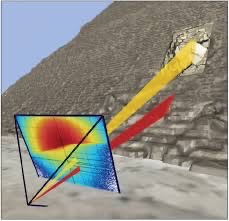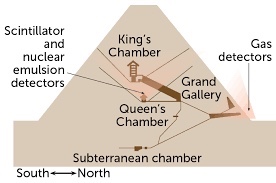

Pyramid Unknown Space: Discovered for the First Time in 186 Years!
ーby observing elementary particles known as muonsー
Egyptian archaeologist:
-Emphasis on the significance of the “greatest discovery of the century” at the press conference-
Inside the Pyramid of Khufu in Egypt, there is a previously unknown space.
It was discovered for the first time in 186 years by an international research team including Nagoya University.
international search team
Egypt and Japan,
France,
Germany,
For the past eight years, an international search team has been conducting research using the latest technology.
Unravel the internal structure of the Pyramid of Khufu built 4,500 years ago.
NHK | News digging
https://www3.nhk.or.jp/news/html/20230302/k10013995831000.html
Pyramid Unknown Space : découverte pour la première fois en 186 ans !
ーen observant des particules élémentaires appelées muonsー
Archéologue égyptien :
-Mise en avant de l’importance de la “plus grande découverte du siècle” lors de la conférence de presse-
À l’intérieur de la pyramide de Khufu en Égypte, il y a un espace jusque-là inconnu.
Il a été découvert pour la première fois en 186 ans par une équipe de recherche internationale comprenant l’Université de Nagoya.
équipe de recherche internationale
L’Égypte et le Japon,
France,
Allemagne,
Au cours des huit dernières années, une équipe de recherche internationale a mené des recherches en utilisant les dernières technologies.
Découvrez la structure interne de la pyramide de Khufu construite il y a 4 500 ans.
NHK | Nouvelles en train de creuser
Pyramid Unbekannter Raum: Zum ersten Mal seit 186 Jahren entdeckt!
ーdurch die Beobachtung von Elementarteilchen, die als Myonen bekannt sindー
Ägyptischer Archäologe:
-Betonung der Bedeutung der „größten Entdeckung des Jahrhunderts“ bei der Pressekonferenz-
Im Inneren der Cheops-Pyramide in Ägypten befindet sich ein bisher unbekannter Raum.
Es wurde zum ersten Mal seit 186 Jahren von einem internationalen Forschungsteam, zu dem auch die Nagoya University gehört, entdeckt.
Internationales Suchteam
Ägypten und Japan,
Frankreich,
Deutschland,
Seit acht Jahren recherchiert ein internationales Suchteam mit modernster Technologie.
Enträtseln Sie die innere Struktur der Cheops-Pyramide, die vor 4.500 Jahren erbaut wurde.
NHK | Nachrichtensuche
International team finds large void in Pharaoh Khufu’s Pyramid in Giza, Egypt
NHK WORLD-JAPAN News
An international team of researchers
says it has confirmed the existence of a large empty space in the pyramid of Egyptian Pharaoh Khufu by observing elementary particles known as muons.
On Thursday, the team announced
its findings, which are said to be the first such discovery in 186 years, in the city of Giza near Egypt’s capital Cairo.
Egyptian Minister of Tourism and Antiquities Ahmed Issa and Associate Professor Morishima Kunihiro of Japan’s Nagoya University,
a member of the team, attended the news conference.
The researchers said
they discovered the void in the shape of a corridor stretching from near the pyramid’s northern slope toward its center.
They say
the space measures 2 meters in width and height, and 9 meters in length.
The team is made up of researchers from Egypt, Japan, France, Germany and elsewhere.
It has been looking into the interior structure of Khufu’s Pyramid since 2015.
The pyramid was built about 4,500 years ago.
The team
employed cosmic-ray muon radiography technology of Nagoya University and the Japan-based KEK High Energy Accelerator Research Organization.
NHK has cooperated in filming video using scopes.
Muons are created when cosmic rays hit the Earth’s atmosphere.
Muons are tiny, so they pass through various substances.
But rocks and other substances with high density tend to reduce the number of particles that pass through.
By taking advantage of this property,
it is possible to see through the internal structure like X-ray photos
by analyzing differences in the amount of muons that pass through buildings and other substances.
The technology has so far been used
in locating volcanic magma and examining the inside of damaged reactors at the Fukushima Daiichi nuclear power plant.
In 2017,
the team used the same technology to obtain data that pointed to the existence of another large void about 30 meters long inside the pyramid, adding to expectations for more new discoveries.
Archaeologist Kawae Yukinori, associate professor of Nagoya University’s Institute for Advanced Research,
says the latest discovery is historic in the study of pyramids.
He said it showed the 30-meter-long void, which the muon radiography detected in 2017, also exists without doubt.
He said there is a possibility that similar empty spaces could be found in other pyramids in Giza.